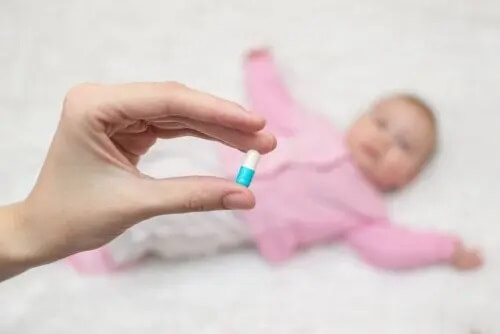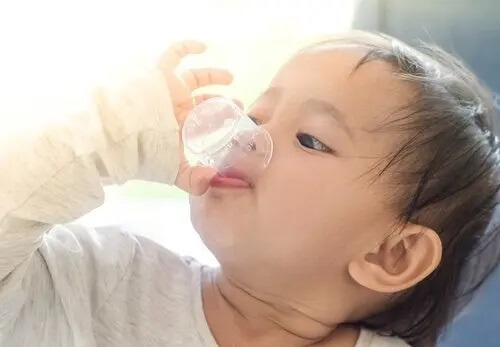Use of Antibiotics in Children: What You Should Know

Most infections in children are due to viruses and usually disappear on their own without treatment. However, antibiotics in children are a very valuable resource for bacterial infections.
However, it’s essential to know how to use them so that they don’t lose their value. Here’s why it’s so important to use antibiotics correctly and why you should always follow your doctor’s instructions.
What are antibiotics?
Antibiotics are drugs used to treat infections that are bacterial in nature. Therefore, they’re not useful in the treatment of other types of infections, such as those that occur because of viruses. This is the answer to the question of why we don’t take antibiotics for colds and the flu.
There are different types of antibiotics against different groups of infection-causing bacteria. They can work by killing the bacteria or by stopping them from reproducing. In each case, the physician will decide which is the most appropriate and what guidelines to follow for the treatment.
One of the best-known antibiotics is amoxicillin, which is a derivative of penicillin. This, in turn, was discovered in 1928 by Alexander Fleming, and was a major milestone in the history of medicine. It was the beginning of the antibiotic era. Since then, these drugs have saved many lives by treating bacterial infections.

The use of antibiotics in children
The most common symptoms of infection in children are fever, pain, and general malaise. But an antibiotic isn’t necessary every time there’s a fever, nor every time an infection occurs, as we’ve said. Most infections in children are viral and don’t respond to or need antibiotics.
The use of antibiotics in children should always follow the pediatrician’s instructions. It’s important to use them in the dosage the doctor prescribes, according to the regimen, and for as long as the doctor indicates. Not all children are the same, nor are all bacteria, nor all infections, nor all antibiotics.
There are antibiotics that the patient only needs to take for 3 days in a single daily dose. At the same time, there are others that require a longer treatment. For example, with doses every 8 hours for 10 days. If we fail to use them properly, they’ll lose their effect and will no longer be effective in the future.
For most antibiotics, there are different presentations on the market. When the pediatrician prescribes them, you can consult the professional regarding the possibility of acquiring the antibiotic in the form of tablets, sachets, syrup, etc. in order to facilitate the administration in children.
It’s important to keep antibiotics, as well as other medications, out of children’s reach. Likewise, never keep leftovers from previous treatments. Whenever necessary, the physician will prescribe the most appropriate antibiotic, as they deem appropriate.
Children should also be educated in infection prevention. The most important measure to avoid contagion is to wash hands with soap frequently. Good hygiene will always help to keep germs at bay.
Side effects
Never forget that antibiotics are medicines and aren’t exempt from producing side effects. That’s another reason why self-medication and the purchase of these drugs without a prescription in pharmacies aren’t allowed.

The most common side effects that usually occur with antibiotic treatment are gastrointestinal, such as diarrhea. Sometimes, these discomforts can be prevented or treated with probiotics. However, in the event of any adverse reaction, it’s important to consult a pediatrician.
The misuse of antibiotics in children
As we’ve said, antibiotics aren’t useful in the treatment of all infections. Therefore, it’s very important to use them only under medical prescription, when the pediatrician considers it appropriate. In addition, the indications provided by the pediatrician must be followed.
In treatment with antibiotics, a very common mistake is to suspend their administration when the symptoms disappear. Generally, between 48 and 72 hours after starting the antibiotic, improvement is already experienced. However, stopping treatment can be dangerous, both in the short and long term.
Misuse of antibiotics causes bacteria to become increasingly resistant. This, in the future, can lead to these drugs no longer being useful against certain infections, which can have serious consequences.
Most infections in children are due to viruses and usually disappear on their own without treatment. However, antibiotics in children are a very valuable resource for bacterial infections.
However, it’s essential to know how to use them so that they don’t lose their value. Here’s why it’s so important to use antibiotics correctly and why you should always follow your doctor’s instructions.
What are antibiotics?
Antibiotics are drugs used to treat infections that are bacterial in nature. Therefore, they’re not useful in the treatment of other types of infections, such as those that occur because of viruses. This is the answer to the question of why we don’t take antibiotics for colds and the flu.
There are different types of antibiotics against different groups of infection-causing bacteria. They can work by killing the bacteria or by stopping them from reproducing. In each case, the physician will decide which is the most appropriate and what guidelines to follow for the treatment.
One of the best-known antibiotics is amoxicillin, which is a derivative of penicillin. This, in turn, was discovered in 1928 by Alexander Fleming, and was a major milestone in the history of medicine. It was the beginning of the antibiotic era. Since then, these drugs have saved many lives by treating bacterial infections.

The use of antibiotics in children
The most common symptoms of infection in children are fever, pain, and general malaise. But an antibiotic isn’t necessary every time there’s a fever, nor every time an infection occurs, as we’ve said. Most infections in children are viral and don’t respond to or need antibiotics.
The use of antibiotics in children should always follow the pediatrician’s instructions. It’s important to use them in the dosage the doctor prescribes, according to the regimen, and for as long as the doctor indicates. Not all children are the same, nor are all bacteria, nor all infections, nor all antibiotics.
There are antibiotics that the patient only needs to take for 3 days in a single daily dose. At the same time, there are others that require a longer treatment. For example, with doses every 8 hours for 10 days. If we fail to use them properly, they’ll lose their effect and will no longer be effective in the future.
For most antibiotics, there are different presentations on the market. When the pediatrician prescribes them, you can consult the professional regarding the possibility of acquiring the antibiotic in the form of tablets, sachets, syrup, etc. in order to facilitate the administration in children.
It’s important to keep antibiotics, as well as other medications, out of children’s reach. Likewise, never keep leftovers from previous treatments. Whenever necessary, the physician will prescribe the most appropriate antibiotic, as they deem appropriate.
Children should also be educated in infection prevention. The most important measure to avoid contagion is to wash hands with soap frequently. Good hygiene will always help to keep germs at bay.
Side effects
Never forget that antibiotics are medicines and aren’t exempt from producing side effects. That’s another reason why self-medication and the purchase of these drugs without a prescription in pharmacies aren’t allowed.

The most common side effects that usually occur with antibiotic treatment are gastrointestinal, such as diarrhea. Sometimes, these discomforts can be prevented or treated with probiotics. However, in the event of any adverse reaction, it’s important to consult a pediatrician.
The misuse of antibiotics in children
As we’ve said, antibiotics aren’t useful in the treatment of all infections. Therefore, it’s very important to use them only under medical prescription, when the pediatrician considers it appropriate. In addition, the indications provided by the pediatrician must be followed.
In treatment with antibiotics, a very common mistake is to suspend their administration when the symptoms disappear. Generally, between 48 and 72 hours after starting the antibiotic, improvement is already experienced. However, stopping treatment can be dangerous, both in the short and long term.
Misuse of antibiotics causes bacteria to become increasingly resistant. This, in the future, can lead to these drugs no longer being useful against certain infections, which can have serious consequences.
All cited sources were thoroughly reviewed by our team to ensure their quality, reliability, currency, and validity. The bibliography of this article was considered reliable and of academic or scientific accuracy.
- Bryant, V., Timoner, J., Oliva, B., Gil, M., Alegre, P., & De Abajo, F. J. (2009). Análisis de la utilización de antibióticos en población pediátrica con patología respiratoria: Estudio en la base de datos BIFAP. Pediatría Atención Primaria, 11, e36-e36.
- Seija, V., & Vignoli, R. (2006). Principales grupos de antibióticos. Temas de bacteriología y virología Médica, 2, 631-633.
- Contreras, J. R. (2018). Consumo de antibióticos y prevención de las resistencias bacterianas. PEDIATRÍA ATENCIÓN PRIMARIA, 20(Suplemento 27).
- Johnston, B., Goldenberg, J., Vandvik, P., Sun, X., & Guyatt, G. (2011). Probióticos para la prevención de la diarrea asociada con antibióticos en niños. Cochrane Database of Systematic Reviews, (11).
This text is provided for informational purposes only and does not replace consultation with a professional. If in doubt, consult your specialist.








